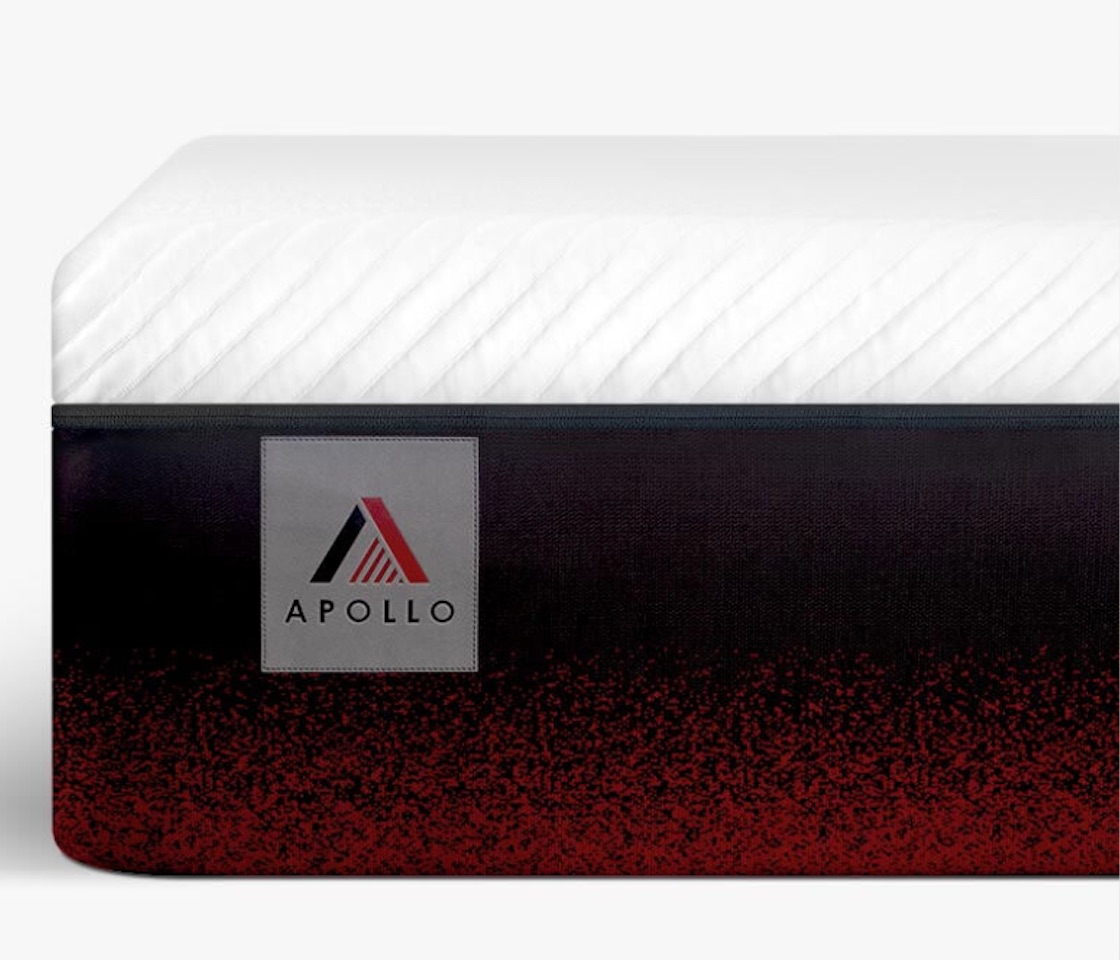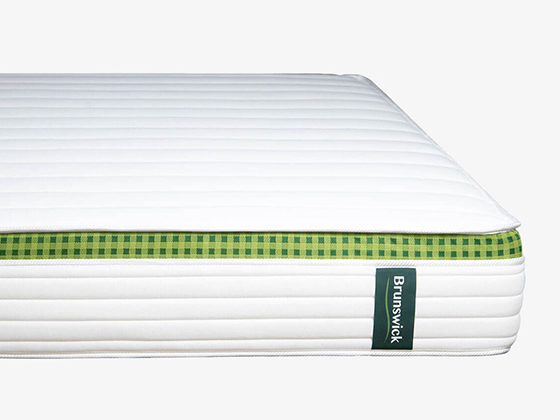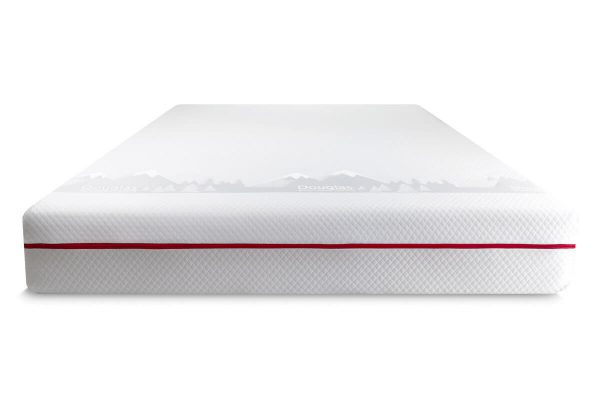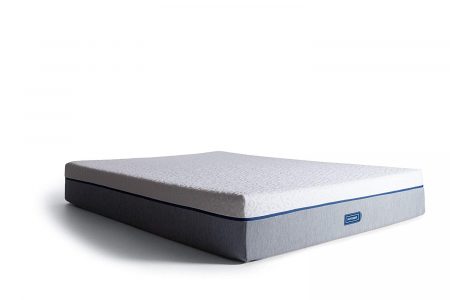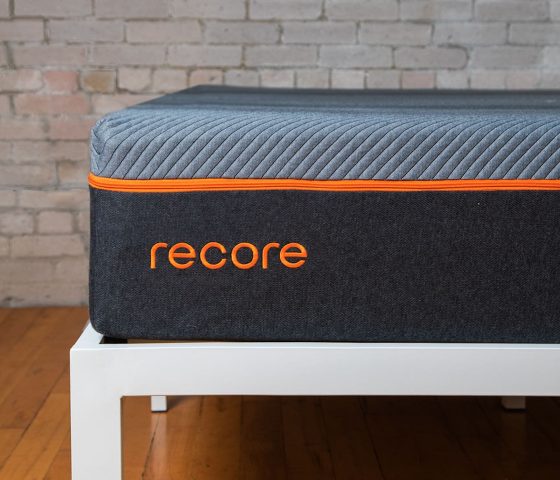Meet Our Testing Team

Brad

Jackson

Keith

Lauren
Recommended for...
- Sleepers who prefer deep body-contouring. The Apollo’s two memory foam layers conform very closely to create a pressure-relieving cradle for the sleeper’s body.
- People who weigh 230 pounds or less. The Apollo has a medium feel, making it best suited to those in the lightweight and average weight groups.
- Couples and co-sleepers. The Apollo’s memory foam layers absorb motion and eliminate most transfer. The mattress is also completely silent when bearing weight.
Not Recommended for...
- Sleepers who prefer more responsive mattresses. The mattress has two layers of memory foam that respond slowly to the body. As a result, the Apollo does not feel very springy or bouncy.
- People who weigh more than 230 pounds. Due to its medium feel, sleepers in the heavyweight group may find the Apollo too soft and prone to uncomfortable sagging.
Ratings Summary
Our testing team conducted an extensive evaluation of the Apollo Mattress. Our review and rating process consists of three parts: in-house evaluation, external sleep testing, and data collection of verified owner experiences. To learn more about our review process, read our methodology here.
Our performance criteria and ratings for the bed are listed in the table below.
As you can see, the Apollo has earned favorable ratings in some categories and lower ratings in others. Strengths of the mattress include motion isolation and pressure relief, as well as above-average edge support. For a detailed look at each performance rating, check our our full breakdown below.
Sleep Position Ratings
As part of our ratings process, we evaluated the Apollo Mattress across different body types and preferred sleep positions. In addition to physical testing, we surveyed our sleep expert team and analyzed reviews from verified mattress owners and customers. Our findings are listed in the table below.
For more information on sleeping positions please see our guides for side, back, stomach, and combination sleepers.
How Is the Apollo Mattress Constructed?
Cover
The Apollo’s cover is made from PolarMAX, a trademarked material designed to keep sleepers cool and wick moisture away from their bodies. Our testers found the cover does not provide any active cooling, but surface-level temperatures were fairly comfortable and they did not feel too warm.
Comfort Layers
The Apollo contains two comfort layers. The first layer features 2 inches of copper-infused memory foam. The material has a medium feel and an indentation load deflection (ILD) of 13. It conforms closely to the body, so sleepers should expect to sink somewhat deeply – especially if they weigh less than 130 pounds. The copper has antimicrobial properties, and may also reduce body heat buildup on the surface.
The second comfort layer consists of 2 inches of open-cell memory foam. This foam, which has an ILD of 25, is a bit firmer than the foam in the topmost layer. The perimeter of this layer is encased with high-density polyfoam. This component ensures stable edge support and reduces sinkage when owners get in and out of bed.
Transitional Layer
The mattress features two transitional layers, as well. The top layer is constructed with 1-inch pocketed nanocoils. These coils have a gauge of 7, making them exceptionally thin. The second transitional layer consists of high-density polyfoam with an ILD of 36, making it much firmer and denser than the comfort layers.
Transitional layers are designed to provide additional reinforcement for the mattress. They prevent sleepers from sinking too deeply into the comfort layers and coming into contact with the denser base materials.
Support Layers
The Apollo’s support core contains 6 inches of high-density polyfoam. This foam has an ILD of 42, making it exceptionally firm. The layer provides good overall stability to the mattress, and sleepers who weigh 230 pounds or less should not experience excessive sagging.
Mattress Height
The Apollo measures 12 inches tall, making it a high-profile mattress. The bed offers two deep comfort layers without sacrificing a thick support system of transitional and base polyfoam. As a result, the Apollo has a balanced, mid-level feel.
| Product Name | Firmness Level | Thickness | Support Core Components | Comfort Layer Components | Cover Components |
|---|---|---|---|---|---|
| Apollo by GoodMorning.com | Medium (5) | 12″ | 6″ 1.8 PCF HD Polyfoam (42 ILD) | 2″ 3.6 PCF Copper-infused Memory Foam (13 ILD) 2″ 2.5 PCF Open-cell Memory Foam with HD Encasement (24 ILD) 1″ Pocketed Nanocoils (7-gauge) 1″ 1.8 PCF HD Polyfoam (36 ILD) |
PolarMAX Fabric |
What Are the Firmness and Feel Like?
The Apollo has a medium (5) feel. This means sleepers sink into the comfort layers a bit, but not to an excessive degree. The memory foam cradles the body closely to cushion the spine and alleviate pressure points throughout the body. This feeling is best described as sleeping “in” – as opposed to sleeping “on” – the mattress.
Most mattresses with coil layers feel at least somewhat responsive, if not very bouncy. The Apollo is an exception. The nanocoil layer measures 1 inch thick and the coils themselves have a very low gauge, so this component does not lend the mattress much springiness. Sleepers will probably not feel much differently on the Apollo as they would on an all-foam memory foam mattress with a mid-level feel.
Ratings Breakdown
Performance Ratings
Next, let’s take an in-depth look at our performance ratings for the Apollo Mattress. Each rating is based on findings from our internal and external testing teams.
Durability
The Apollo was first unveiled in 2020. Because this model is so new, we have not had enough time to evaluate it against the average mattress lifespan of six to eight years. Our durability rating for the Apollo is based on other factors, such as quality of design, owner experiences, and GoodMorning.com’s overall reputation as a mattress maker.
We estimate the Apollo will perform for seven to seven and a half years before a replacement is needed. This expected lifespan is on par with the average memory foam model. The bed’s transitional and base foam are fairly sturdy and should provide decent stability, but owners should expect the comfort layers to deteriorate more quickly – a common issue for beds with softer top layers. Over time, the surface may develop body impressions that make the bed feel uneven and unsupportive.
Owners can safeguard the mattress from excessive impressions by rotating the mattress head-to-foot every three to six months.
Motion Isolation
To evaluate the Apollo for motion isolation, we asked two of our sleep testers to lie down on the mattress at the same time. One tester moved around on their side while the other felt for movement transferring across the surface. During these tests, the Apollo demonstrated very good motion isolation. The surface foam absorbed most motion, resulting in minimal transfer, and the nanocoils did not affect the bed’s ability to isolate movement.
Off-Gassing
Our testers noticed a small amount of initial off-gassing odor when they unboxed the Apollo, and these smells had completely dissipated when they re-evaluated the mattress a few days later. Off-gassing commonly occurs with memory foam beds, but the Apollo has lower odor potential than most. This can be attributed in part to its nanocoil transitional layer, which promotes enough airflow to rid the mattress of bothersome smells.
Pressure Relief
To evaluate the Apollo for pressure relief, our testers took turns lying on the mattress with a sensory pad that tracks pressure buildup in the shoulders, hips, and other sensitive areas of the body. The testers also shifted positions to see if pressure increased or decreased on their sides, back, and stomach.
Our testers who weigh 230 pounds or less agreed that pressure relief is a key strength of this mattress. The memory foam layers conform to a noticeable extent but none of the lightweight or average weight sleepers experienced excessive sagging. The Apollo is particularly well suited for side sleepers. Its medium feel ensures ample padding for the shoulders and hips, which can improve spinal alignment – a common issue associated with this sleep position.
Temperature Neutrality
The Apollo is designed with many features intended to make the mattress sleep cool. These include a moisture-wicking cover, copper-infused and open-cell memory foam comfort layers, and a nanocoil transitional layer for added air circulation.
That said, the bed’s temperature neutrality is slightly better than the average all-foam model. This is due in part to the bed’s medium feel. As sleepers sink into the memory foam, they experience less surface airflow and may feel too warm. Those who tend to sleep hot may find some relief on the Apollo, but they will probably feel more comfortable on a mattress with a thicker coil layer to promote additional airflow.
Edge Support
To evaluate the Apollo for edge support, our testers sat along the perimeter of the mattress as an owner might do when getting on and off the bed. All of the testers noticed some sinkage, but the Apollo performed fairly well in this category compared to its all-foam competitors. This is largely due to the high-density foam encasement around the second comfort layer, which provides enough push-back to keep the edges from sagging excessively.
The testers also took turns lying near the edges to check for feelings of “roll-off.” The Apollo performed very well for sleepers who weigh 230 pounds or less, but heavier testers felt less secure next to the perimeter.
Noise
The Apollo was completely silent during all of our tests, including those that involved people moving around on the mattress. This trait is common among all-foam beds. The Apollo technically is not all-foam due to its nanocoil layer, but the coils do not produce any noise, either.
Given the Apollo’s strong motion isolation and noise-free design, we recommend the mattress to anyone who awakens easily due to their sleep partner’s movements.
Sex
The Apollo’s memory foam responds slowly to the body and does not offer much surface-level bounciness. As a result, couples that prefer springy mattresses for sex may not enjoy the Apollo as much. However, the foam conforms closely to provide great traction, and the reinforced perimeter allows couples to use the entire bed without worrying about rolling off the edge. The mattress is also completely silent, making it discreet for amorous activities.
Sleeper Ratings
The ideal firmness and thickness for a mattress largely depend on a sleeper’s body weight, shape, and preferred sleep position. In order to better inform our readers and avoid subjectivity in our review, our team evaluated the bed with sleep testers of varying body types and position preferences.
Lightweight Sleepers – Less than 130 lbs.
Our lightweight testers all gave favorable ratings to the Apollo, but some sleep positions felt more comfortable than others. For side sleepers weighing less than 130 pounds, the mattress provided enough cushioning to the shoulders and hips to align the spine and alleviate pressure points.
Back sleepers also found the mattress comfortable and supportive in equal measure. They sank a bit but did not sag excessively. Stomach sleepers in the lightweight group noticed more sagging, especially around the hips, but the Apollo still kept their bodies on a fairly even plane.
Average Weight Sleepers – 130 to 230 lbs.
Average weight side sleepers also found the Apollo very comfortable, and for the same reasons as their lighter counterparts. The memory foam contours closely without sinking to promote proper spinal alignment, reducing pressure in the process.
Back and stomach sleepers weighing between 130 and 230 pounds felt a bit differently. The mattress sank beneath their torso, stomach/lower back, and hips while the rest of their body was supported. Over time, this can lead to aches and pains in the neck, shoulders, and other areas. That said, these testers still felt reasonably comfortable and gave the mattress a favorable rating.
Heavyweight Sleepers – More than 230 lbs.
Our heavyweight testers were more divided about the Apollo. Side sleepers weighing more than 230 pounds found the mattress a little too soft. They noticed some sinkage around the shoulders and hips, which led to some added pressure in those areas. For back and stomach sleepers, the mattress did not feel supportive. All of these heavyweight testers noticed excessive sagging in some areas.
Heavier people generally need medium firm or firm mattresses to feel comfortable. Softer models like the Apollo tend to sink too much, leading to more discomfort and pressure points. We recommend a firmer mattress for back and stomach sleepers in this weight group.
Pricing and Discounts
- Twin $949 (CAD)
- Twin XL $1,049 (CAD)
- Full $1,179 (CAD)
- Queen $1,249 (CAD)
- King $1,449 (CAD)
- Cal King $1,449 (CAD)
Get the Apollo Mattress at the lowest price today.
Other GoodMorning.com Products
How Does the Apollo Mattress Compare to Other Beds?
When looking for a new mattress, we encourage all shoppers to compare different brands and models to find a bed that best meets their needs. In the next section, we’ll see how the Apollo stacks up to other GoodMorning.com models.
Apollo vs. Brunswick
The Brunswick is a hybrid mattress. Like the Apollo, the Brunswick contains two memory foam layers, but the latter has a medium firm feel and does not conform as closely. The Brunswick also has a pocketed coil support core, which creates some responsiveness on the surface. The Apollo’s nanocoil layer does not provide the same level of support and its surface has little to no bounce.
The two mattresses excel in different areas. The mostly all-foam Apollo offers better motion isolation and alleviates more pressure, while the Brunswick feels more secure around the edges. Its thick layer of pocketed coils also promote steady airflow, allowing the mattress to sleep noticeably cooler than the Apollo. Both of these GoodMorning.com mattresses are exclusively sold and shipped within Canada.
The Brunswick costs considerably less than the Apollo, but both mattresses are reasonably priced. Those who like more springiness and support from their bed should consider the Brunswick, while the Apollo is better suited to side sleepers, people with pressure points, and others that benefit from deep body-contouring.
Read our full Brunswick Mattress Review.
Apollo vs. Douglas
The Douglas by GoodMorning.com is an all-foam model with a memory foam comfort layer, followed by polyfoam transitional and base layers. The Douglas has a medium firm (6) feel, making it better suited to heavier people than the Apollo – but less suitable for those who weigh less than 130 pounds. Sleepers experience some body-contouring with the Douglas, but they won’t sink very deeply.
Since the Apollo and Douglas are both all-foam beds, they have earned comparable performance ratings across the board. These include favorable ratings for categories like motion isolation, pressure relief, and noise. They also provide stronger-than-average edge support and sleep fairly cool. Like the Apollo, the Douglas is only available to Canadian customers.
One key difference is pricing, as the Douglas costs much less than the Apollo. Shoppers with more flexible budgets should base their decision on firmness preference. People who like close contouring should opt for the Apollo, and those who want less conforming and more support will probably find the Douglas more comfortable.
Read our full Douglas Mattress Review.
Apollo vs. Logan & Cove
The Logan & Cove hybrid is a bit different from GoodMorning.com’s other models. The mattress features a 4-inch pillow-top containing comfort layers of silk fill, gel polyfoam, memory foam, and soy-based bio-foam. The support core contains an additional layer of dense bio-foam, followed by pocketed coils. The bed’s various components create a balance of body-contouring and responsiveness, much like other competing hybrids.
Customers can choose from two feels for their Logan & Cove: medium soft (4.5) or medium firm (6.5). As expected, medium soft Logan & Cove models conform a bit closer than the Apollo, while the medium firm beds provide minimal contouring. Neither firmness option offers the deep, pressure-relieving cradle of the Apollo, but both feel more supportive. The Logan & Cove is much more breathable and temperature-neutral, as well. Both models are sold exclusively within Canada.
The Logan & Cove is very inexpensive for a hybrid model, whereas the more expensive Apollo has a price-point that is on par with the average foam mattress. We recommend the Apollo for sleepers who want a mattress that responds slowly and conforms very closely, while the Logan & Cove will be a better fit for those who enjoy a springier feel.
Read our full Logan & Cove Mattress Review.
Apollo vs. Novosbed
The flagship Novosbed was the first mattress released by GoodMorning.com (then Novosbed, Inc.). Unlike other models from the brand, the Novosbed is available to customers in the U.S. and Canada. It is constructed with two memory foam layers over a high-density polyfoam base. Customers can choose from three firmness levels for their Novosbed: soft (3.5), medium (5.5), and medium firm (6.5).
The soft and medium Novosbed models are fairly similar to the Apollo in terms of feel, conforming ability, and pressure relief. We recommend these firmness levels for sleepers who weigh up to 230 pounds. The medium firm Novosbed is better suited to heavier individuals, and less so for those in the lightweight group. The Novosbed’s edge support is a bit weaker than the Apollo’s, leading to more sinkage when owners get in and out of bed. For other performance categories, such as motion isolation and temperature neutrality, both the Apollo and Novosbed have earned comparable ratings.
The Novosbed’s price-point is a bit lower than the Apollo’s, but both models are considered high-value all-foam mattresses. Choosing between these two beds mostly comes down to firmness preference. Those who feel most comfortable on soft or medium firm beds should select the Novosbed, but for people who would rather sleep on a medium-feel mattress, the decision is essentially a toss-up.
Read our full Novosbed Mattress Review.
Apollo vs. Recore
The Recore is GoodMorning.com’s only model with a latex comfort layer – graphite-infused synthetic latex, to be precise. Other components include a gel-infused polyfoam transitional layer and a high-density foam base. The mattress has a medium firm (6.5) feel and the latex makes the surface feel fairly responsive. This results in a combined feeling of sleeping “in” and sleeping “on” the mattress, as opposed to the Apollo’s deep body-cradling.
Although latex tends to absorb less body heat than memory foam, both the Apollo and Recore offer comparable levels of temperature neutrality. They also provide above-average edge support, so owners won’t sink too much when getting in and out of either bed. The Recore, like the Apollo, alleviates pressure very well, but this model is better suited to heavier individuals due to its medium firm feel. Both mattresses are only sold and shipped within Canada.
Latex beds tend to be pricey, but the Recore has a price-point that is significantly below average for its mattress type. The Apollo is more expensive by comparison. Sleepers who like a mix of contouring and responsiveness may feel more comfortable on the Recore, while the Apollo is a better option for those who enjoy the feeling of sleeping “in” their bed.
 |  |  |  |  |  | |
| MATTRESS TYPE | ||||||
| PRICE RANGE | ||||||
| FIRMNESS | ||||||
| AVAILABILITY | ||||||
| SLEEP TRIAL | ||||||
| WARRANTY LENGTH |
Apollo Mattress FAQ
-
Sleep Trial 120 nights
-
Shipping Free for most of Canada
-
Warranty 15 years, partially prorated
-
Made In Canada
-
Where Can I Buy the Apollo Mattress?
The Apollo is exclusively available on GoodMorning.com. The company only ships within Canada. This mattress is not sold through any third-party retailers or online marketplaces, including Amazon.com, and GoodMorning.com does not operate any brick-and-mortar locations.
-
Where Do They Ship?
GoodMorning.com ships to most destinations within Canada, but delivery may not be available to some remote locations.
-
White Glove Delivery?
GoodMorning.com does not offer White Glove delivery at this time.
-
Old Mattress Removal
Old mattress removal is not available with any GoodMorning.com orders.
-
Full Delivery Policy
The delivery policy for GoodMorning.com is as follows:
- At this time, the Apollo cannot be shipped anywhere outside of Canada. Standard shipping is free for most customers in Canada, but additional fees may be applied for remote addresses.
- For most deliveries, a customer signature is not required.
-
Trial Period and Warranty Details
Trial Period and Guarantee: GoodMorning.com offers a 120-night sleep trial for the Apollo Mattress.
- This sleep trial requires a 30-night break-in period. Customers may not return their mattress for a refund until at least 30 nights have elapsed.
- The sleep trial begins on the delivery date.
- Full refunds are issued to all returns between 30 and 120 nights. GoodMorning.com will also arrange for the mattress to be picked up at no extra charge to the customer. All returned mattresses are recycled or donated to charity.
Warranty: GoodMorning.com offers a 15-year warranty for the Apollo:
- The warranty is partially prorated. During the first 10 years, GoodMorning.com will repair or replace a defective mattress at no extra charge to the owner. Beginning in Year 11, owners must pay 75 percent of the original mattress price if a replacement is needed.
- The warranty will be voided if the mattress is not removed from its packaging within two weeks of the delivery date and damages are reported.
- Warranty coverage is contingent on proper foundational support. Per GoodMorning.com: “Purchasers using a bed frame must ensure it provides sturdy support for both the mattress and foundation; including a center support and having at least 5-6 legs for queen, king, and California king, and 4 leg support for twin and full mattresses. Purchasers using their mattress directly on a slatted bed system must ensure that the slats are a minimum of 2 inches in width, and have gaps between them of no more than 3 inches. Queen, king, and California king platform beds and slat system bed frames used in conjunction with your [mattress] require at least one center support beam.”
- Mattress owners are responsible for shipping and transportation costs associated with repairs or replacements.
- The warranty will cover visible sagging or indentations in the sleep surface measuring 2 inches or deeper. The warranty also covers physical flaws in the mattress that cause materials to split or crack.
- The warranty does not cover sagging or indentations of less than 2 inches. Additionally, the warranty will not cover repair or replacement requests that occur due to changes in the owner’s comfort preferences, or physical damage such as burns, cuts, or stains.
- This warranty is non-transferable. It is exclusively available to original owners who purchase their Apollo from GoodMorning.com or an authorized retailer. Those who buy or acquire their mattress from the original owner or a non-authorized retailer do not qualify for warranty coverage.
Company Information
-
Customer Service
8 out of 10 owner experiences show that customers have had a positive experience with GoodMorning.com, irrespective of whether or not they liked their mattress.
-
Company History
Novosbed Inc. first launched in 2009. The company changed its name to GoodMorning.com in 2018. The Apollo was introduced in 2020.
-
BBB Rating
GoodMorning.com currently holds an ‘A+’ rating with the Better Business Bureau.
-
Physical Stores
GoodMorning.com does not operate any brick-and-mortar locations.
-
Contact GoodMorning.com
Online email form | 1-833-310-0302 | GoodMorning.com
-
Find GoodMorning.com on Social
